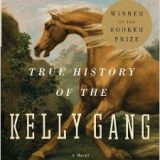True History of the Kelly Gang – Peter Carey – 2000
Posted by Ülkü Ören on 19/8/2006, 10:22:01
Am I the first to finish reading True History of the Kelly Gang?
First, I would like to introduce myself to the group. My name is Ülkü Ören. After recently re-claiming my freedom from the hard labour of the corporate world, I have now, time to do what I always want to do… Read books, learn oil-painting, do gardening and hopefully some travelling.
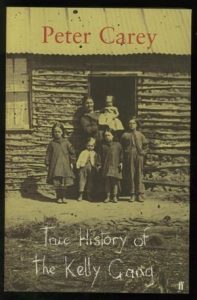 I’ve had the pleasure of reading your club’s choice for the month of August. This is the first book I’ve read written by Peter Carey. I admired the author’s ability to paint such a vivid colourful picture of the Australian bush land, its people in 19th century, and their culture and folklore. It was like talking to Ned Kelly himself, and walking about the land in those days. That is why I say: “Eat your heart out Lynne Truss.” Who says you can’t properly express yourself without commas? Run on sentences are at their best in this book.
I’ve had the pleasure of reading your club’s choice for the month of August. This is the first book I’ve read written by Peter Carey. I admired the author’s ability to paint such a vivid colourful picture of the Australian bush land, its people in 19th century, and their culture and folklore. It was like talking to Ned Kelly himself, and walking about the land in those days. That is why I say: “Eat your heart out Lynne Truss.” Who says you can’t properly express yourself without commas? Run on sentences are at their best in this book.
The book was interesting as it conveyed the police brutality over the Irish immigrants and lawlessness of the land at the time very well. I also found interesting the relationship between Ned and his mother… his clear devotion to her and her struggle to survive (even if it meant to harm him at times)… She always expected something from him for her and her children to survive.
Another point that intrigued me was the helpless of children, especially the girl-child. Just like in any other society… How they were (and they still are) the ones very easily abused at very early age.
I am curious to hear the group’s impression of the Kelly Gang…
~
Posted by Lale on 20/8/2006, 12:22:04
: That is why I say: “Eat your heart out Lynne Truss.” Who says
: you can’t properly express yourself without commas? Run on sentences
: are at their best in this book.
Ülkü is referring to the extremely popular book Eats, Shoots & Leaves: Why, Commas Really Do Make a Difference! by Lynne Truss and Bonnie Timmons.
A comma can be worth 2.13 million dollars. A contractual disagreement between two Canadian telecomm companies came down to the position of a single comma. Rogers Communications lost the case and would have been 2.13 million dollars out of pocket but was saved in the appeal by the examination of the French version of the same contract which removed the ambiguity. Bilingualism rocks (http://www.lawnow.org/comma-law/)
I started reading the book last night and I found it very gripping. The style is easy to get used to. It makes me hear the voice of a sincere, unsophisticated man telling a story in oral form.
Apparently, there is a Ned Kelly movie (2003) based on the novel “Our Sunshine” by Robert Drewe, written in 2002. Peter Carey’s “The True History of Kelly Gang” was written a couple of years earlier.
Lale
~
Posted by Steven on 20/8/2006, 20:15:19
: I started reading the book last night and I found it very gripping. The style is easy to get used to.
: It makes me hear the voice of a sincere, unsophisticated man telling a story in oral form.
Yes, my reaction is exactly the same. I started it last night as well, and am almost halfway through.
: Apparently, there is a Ned Kelly movie (2003) based on
: the novel “Our Sunshine” by Robert Drewe,
: written in 2002. Peter Carey’s “The True History
: of Kelly Gang” was written a year earlier.
Your comment reminded me that I had a stamp from Australia in my collection with a “Kelly Gang” movie poster. The stamp was issued in 1995, but the poster pictured on it is from a 1906 production which is considered to be the world’s first feature length film. Unfortunately, only fragments of the film survive.
Here is an article about the film:
http://en.wikipedia.org/wiki/The_Story_of_the_Kelly_Gang
And here, from the Australian National Film & Sound Archive, is a collection of still photographs from the 1906 movie:
http://www.screensound.gov.au/Screensound/Screenso.nsf/Web+Pages/4302DDD48031F908CA256EEB00252EFA?OpenDocument
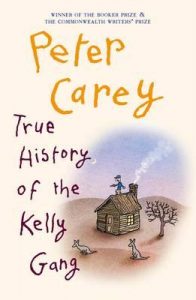
Posted by LadyPurple on 22/8/2006, 6:44:08
Thanks for the links, Steven.
I remember seeing a b/w movie version of the Kelly Gang, but evidently it was not the 1906 first film as it did not survive. So it must have been the 1920 version.
I have just started the book and will join in as soon as I can.
Friederike
~
Posted by Lale on 21/8/2006, 8:29:28
I don’t understand how James Kelly, brother of the father, could have gotten to Australia and found his nephews? Is this a weak link in the story? The father had committed a crime in Ireland and was shipped to Van Diemen’s Land for punishment. It follows that he didn’t have any relatives in Australia other than the ones he acquired by marriage. Then this James Kelly guy shows up, in the middle of nowhere, and tells Ned and Dan that he is their uncle. How did he even find them? This is 1860s. The family had just moved to Greta. It doesn’t seem plausible to me that an uncle from Ireland could come and find them in an immense country.
What do you think?
Lale
~
Posted by Lale on 21/8/2006, 8:43:52
“Adjectival” is very cute.
“Get out of my adjectival chair.”
Lale
~
Posted by Steven on 21/8/2006, 11:16:08
Welcome to the group, Ülkü!
: I also found interesting the relationship between Ned and his mother.
Yes, it reminds me very much of Paul and his mother in D. H. Lawrence’s “Sons and Lovers.” And there are incidents and themes between Ned and Mary (I won’t be specific since others probably haven’t read that far yet) that emphasize Ned’s fixation with his mother.
Sexual ambiguity seems to be a theme running throughout the novel. I haven’t quite finished it yet, so I don’t know if the men wearing dresses is ever explained, but there are several references to possible homosexuality, incest, castration anxiety, various fetishes, Oedipal impulses and gender role reversal.
Steven
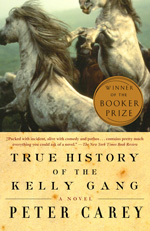
Banshee – Posted by Lale on 23/8/2006, 10:56:54
There are a lot of banshee illustrations on the internet.
Lale
~
Banshee or ‘Bean-sidhe’ is Irish for faerie woman – ban (bean), meaning a woman, and shee (sidhe), meaning faerie. The banshee can appear in one of three guises: a young woman, a stately matron or a raddled old hag. These represent the triple aspects of the Celtic goddess of war and death, namely Badhbh, Macha and Mor-Rioghain.
She usually wears either a grey, hooded cloak or the winding sheet or grave robe of the unshriven dead. She may also appear as a washer-woman, and is seen apparently washing the blood stained clothes of those who are about to die. In this guise she is known as the bean-nighe or washing woman. She always has long flowing hair and eyes red from crying.
When someone is about to die, the Banshee appears at the family’s home during the night and weeps and wails. Sometimes, the Banshee cries for several nights in a row. Her sharp, cries and wails are also called ‘keen’. The wail of a banshee pierces the night, it’s notes rising and falling like the waves of the sea, it always announces a mortal’s death.
She is solitary woman fairy, mourning and forewarning those only of the best families in Ireland, those with most ancient Celtic lineages, whose names begin with ‘Mac/Mc’ or ‘O’. According to tradition, the banshee can only cry for five major Irish families: the O’Neills, the O’Briens, the O’Connors, the O’Gradys and the Kavanaghs. Intermarriage has since extended this select list.
Each Banshee has her own mortal family and out of love she follows the old race across the ocean to distant lands. Her wails or keen can be heard in America and England, wherever the true Irish have settled.
When a member of the beloved race is dying, she paces the dark hills about his house. She sharply contrasts against the night’s blackness, her white figure emerges with silver-grey hair streaming to the ground and a grey-white cloak of a cobweb texture clinging to her tall thin body. Her face is pale, her eyes red with centuries of crying.
She is also know as White Lady of Sorrow and Lady of Death. Unseen, banshees attend the funerals of the beloved dead. Although, sometimes she can be heard wailing, her voice blending in with the mournful cries of others.
~
Blutchers – Posted by Lale on 23/8/2006, 11:00:07
It is hard to find a visual of the blutchers used in 1860s Australia. Google comes up with these. (Today’s fashion, obviously)
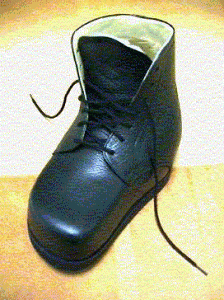

~
Fact and Fiction – Posted by Steven on 29/8/2006, 13:43:06
Here is a link to an analytical review of Carey’s novel pointing out which details are historically true and which are not. Obviously, there are spoilers here for those who haven’t finished the book.
http://www.bailup.com/booksTrueHistoryKellyGang.htm
~
Posted by Kenny on 4/9/2006, 20:27:08
I have recently discovered this book club and it is information such as this that impressed me with it’s usefulness. I was delighted to see that about half the selections were books that I had read or was planning to read. Most of the rest were interesting suggestions. Well selected. I have recently become interested in Australian and New Zealand literature. “Kelley Gang” has much of the feel of the “Rolf Boldrewood” stories of the nineteenth century. Thanks for the suggestion and I look forward to further readings.
~
Posted by Lale on 4/9/2006, 22:03:31
What happened to Jem Kelly? Ned and Dan are now together but Jem fell off of the edge of the Australia.
It is really hard to keep track of the Kelly children: Annie (died but left a baby from Constable Flood), Ned, Jem, Maggie (these last two might be the other way around), Kate, Dan (these last two might also be the other way around), Gracie, Ellen (from Bill Frost, died), and two more babies from George King, I forgot their names, and another one (mother was pregnant when George left her with two babies and then she went to jail with this last baby).
Does anyone have a different account?
~
Posted by Steven on 1/9/2006, 19:47:45
We’ve read two books this year about a young man who becomes a reluctant outlaw, then a legendary champion of the people. It’s interesting to compare them…
Memed, My Hawk, is an entirely fictional story inspired by historical events and characters. The True History of the Kelly Gang is a fictionalized story about real people and events.
Both Memed and Kelly fall in love with a young woman who is unable, or unwilling, to keep up with their life as fugitives.
Both men are at large while a woman they love is in prison, though in Kelly’s case it is his mother.
Both men were raised by their mothers after their father died, and both start out as the protege of another bandit.
Both men let their own legend go to their heads, shaking the support of their followers and causing them to take unwise risks.
Their deepest motivations, however, are very different. Memed’s is revenge. Kelly’s is his obsessive love for his mother.
Where the novels differ most, I think, is that Kelly Gang focuses on the individual psyche of the characters – especially Ned Kelly with his Oedipus complex and mammary fixation – while Memed, My Hawk, is more about group behaviour – the way the villagers are swayed for and against Memed.
… Two very good, and basically similar novels with some important differences.
Steven
~
Posted by Lale on 15/9/2006, 12:45:58
I finally finished the Kelly Gang. Last Night! The last 50 pages took forever, I had time to read only a few pages every night. If that wasn’t the case, the book is actually very gripping and could be finished in a week.
I liked it. It is quite similar to Memed My Hawk, but more interesting. I liked the style better. But at some points it really resembled Memed in its confusion. For instance the location, the country sides they travel through. It is hard to keep track of that. Oh, and I lost complete count of the horses that were stolen from Kellys, stolen by Kellys, lost, found etc.
It is a story that makes you curious about the real events. Today I will read all the relevant info about Ned Kelly Outrage and the link Steven provided which compares real-life events and the book.
Lale
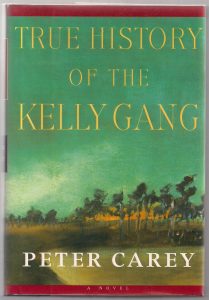
Posted by Lale on 17/9/2006, 10:30:12
http://www.bailup.com/booksTrueHistoryKellyGang.htm
Steven, thanks for finding this link. I read the entire comparison and it was quite interesting.
It is amazing how the gang became the talk of the country, in both fact and fiction. I suspect there were many more outlaws in Australia at the time, but Ned Kelly becomes an obsession; it becomes The Kelly Outrage.
I am still curious about some of the other brothers and sisters. Kate and Maggie are there up until the end but Jem disappeared early on in the story. I don’t remember if we are told about Gracie but I suspect she must have been living with either Kate or Gracie. Ellen’s last-born is taken from her and I wonder if she/he is given to the sisters or to a foster home.
Lale
~
Posted by Lale on 17/9/2006, 10:33:25
http://www.smh.com.au/articles/2002/06/13/1023864322081.html
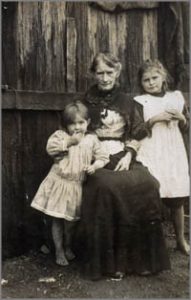
Mrs Ellen Kelly with grandchildren. Lot 131
Ned Kelly’s mother, Ellen, then 79, with two of her grandchildren.
===
March 23 2002
As historical photographs go on sale, Geoff Maslen takes a look at the early days of a wild brood.
She peers out at us from the long past. Years of tragedy and privation have taken their toll but, even at 79, Ellen Kelly looks strong and resourceful as she always was.
The story of Ned Kelly’s mother was as dramatic and even more eventful than his and now, after 125 years, she is in the public eye again.
A collection of early photographs she compiled of her wild brood, their relatives, friends and comrades-in-arms will go for auction at Christie’s saleroom in South Yarra on Tuesday. Some of the photos date from the 1870s. They pull back time’s curtain to provide a glimpse of legendary people who have become part of our history.
Christie’s head of rare books and manuscripts, Michael Ludgrove, estimates the 100 or so photos could fetch up to $200,000. They contain previously unknown pictures of Ned, his mother and members of the Kelly gang likely to create new saleroom records. The highest auction price for a Ned Kelly photo was set in 1987 at Sotheby’s in Melbourne when a tattered, full-length shot of Ned in fighting pose fetched $19,800.
Christie’s catalogue cover, though, shows Ned “in his respectable years”.
With a $20,000 estimated price, it is the most highly valued and is also the only known image from the “honest, hard-working period” of his life.
Yet it is the tiny, sepia-toned pictures of Ellen Kelly that capture the imagination. In one, taken to celebrate her release from prison in 1881, we see her with some of her children, the family dog and friends outside the slab and bark-roofed Kelly homestead, built by Ned four years earlier.
Another shows her at the age of 79 in 1911 with two grand-daughters, sitting outside the last house she occupied, while a third, a 1917 portrait, was taken at Benalla railway station as she waited for the Melbourne train.
Nell Kelly lived through the days of the Victorian goldrushes, the pioneering horse-and-buggy, candles and kerosene-lamp era. She was still alive when the first steam trains puffed their way north to the Murray River at Echuca, when the first motor cars coughed their way across the dirt roads, when the first planes spluttered across the sky, when electricity replaced gas lamps and ghostly voices could be heard coming from the wireless.
Nell, who was born in 1832 in County Antrim, Ireland, married twice in Australia, and in October, 1878, the widowed mother of 11 was sentenced to three years’ hard labour for a crime she did not commit.
She lived to tell her great-grandchildren of her exploits right up to her death in 1923.
“People blame my boys for all that has happened,” she recalled. “They should blame the police. They were at the bottom of it all … We were not getting too rich but were doing all right. It was a lonely life but we were all together and we all loved each other so dearly.
“The trouble began over a young constable named Fitzpatrick … He tried to kiss my daughter, Kate, and the boys tried to stop him. They were only trying to protect their sister but his story was believed … After that, nothing but misery. And it has been nothing but misery ever since.”
Fitzpatrick had gone to the house to arrest Ned’s brother Dan. Photos of them will be sold on Tuesday. The policeman was a liar, perjurer and drunkard and soon after was sacked. But not before Justice Sir Redmond Barry the man who later sentenced Ned to hang sent Ellen away for three years, even though she had a baby at the breast.
In his Jerilderie letter, a copy of which sold at Christie’s last August for $58,750, Ned wrote bitterly of Fitzpatrick and the other police who persecuted the family: “They kept them six months awaiting trial and then convicted them on the evidence of the meanest article that ever the sun shone on … [Fitzpatrick] has the wrong appearance of a manly heart the deceit and cowardice is too plain to be seen in that puny cabbage hearted looking face …”
On November 10, 1880, Nell visited her first-born son the night before he went to the gallows. Her last words were: “Mind you die like a Kelly, Ned.”
Legend has it that as the noose was tightened around his neck, Ned murmured philosophically, “Such is life.” He was 25.
THE FAMILY TREE
– Ellen Kelly (née Quinn): sailed with her family from Ireland to Australia. Eloped at 18 with an Irish ex-convict, John “Red” Kelly, and married him in 1850. They had eight children before Red died in 1866.
– George King: A Californian married Ellen in 1874 and they had three children. King disappeared after becoming involved with Ned Kelly in 1878.
– Ned Kelly: Ellen’s third child and first son. Born June, 1855, hanged at Melbourne in November, 1880.
– Dan Kelly: Sixth son of Ellen and the last of the three boys born to Red Kelly. Died in the shootout at Glenrowan in June, 1880.
– Joe Byrne and Steve Hart: Kelly gang members who also died in the battle at Glenrowan.
===
Posted by Lale on 17/9/2006, 10:42:24
http://www.ironoutlaw.com/html/kelly_country.html
This link has photos of all the main characters.
Lale
~
Posted by Lale on 18/9/2006, 11:32:54
All these people were forced to become outlaws or at least outcasts after they have done something really small in the grand scheme of things. Harry Power was sent to Tasmania for having stolen a pair of shoes. Ned Kelly’s father John Kelly was sent there for stealing a pig. Joe Byrne and Aaron Sheritt were imprisoned for being in possession of stolen meat.
Instead of solving the poverty or the inequality problems, we simply choose to punish (and punish severely) those who disobey the law out of desperation.
Lale
~
Posted by Steven on 18/9/2006, 15:03:14
In the mid-19th Century you could also be imprisoned or deported to Australia simply for being unable to pay your debts. I’m sure it was hard to resist the temptation to steal if you knew you were going to prison regardless.
There have been enormous changes in developed countries since then, and it’s much less likely now that someone would find himself compelled to commit a crime to meet basic physical needs such as food.
Steven
~
Posted by Steven on 20/9/2006, 11:12:40
Thanks for the link, Lale. It has lots of information and photos, including the actual body armor worn by the Kelly Gang.
Though theirs was homemade, body armor of this type (minus the helmet) wasn’t unheard of at that time. The problem was that to stop a rifle bullet the armor had to be so thick and heavy that it was almost unwearable, as Kelly found out.
At the start of the American Civil War in 1861, merchants in the North did a brisk business selling body armor to soldiers as they went off to war. But it didn’t take long for the soldiers to realize that they couldn’t carry a suit of armor, along with a 50 pound pack and rifle, on a 20-mile march. Cast off armor vests soon lined the roadsides, and they were almost never worn in battle. Ironically, however, it was the armored warships of the Civil War that (in the novel, at least) gave Kelly the inspiration for his body armor.
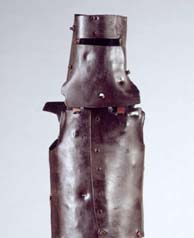
Steven
~
“Ned Kelly” the Movie – Posted by Steven on 22/9/2006, 7:21:29
I recently watched the 2003 movie with Heath Ledger that is based on a novel “Our Sunshine” by Robert Drewe to see how the story compared with the Peter Carey novel.
It isn’t a great film, but one worth watching if the Kelly Gang story interests you. Starting with Kelly’s arrest for horse theft, it packs a lot of people and events into two hours, but at the expense of character development.
Both versions of the story are fictional and to roughly equal degrees. Each expands on Kelly’s love life, especially the Carey novel. The film omits Harry Power and softens up Ellen Kelly. And while the novel we read dwells heavily on the psychological aspects of Kelly’s life and his feelings about his mother, the film is a simpler story of the oppressed Irish fighting back against the English authorities.
Has anyone else seen it, or any of the other movie versions of the Kelly Gang legend?
Steven
~
11 movies!!! – Posted by Lale on 27/9/2006, 20:00:54
1906 version seems to be quite interesting, first feature-length movie.
Lale


